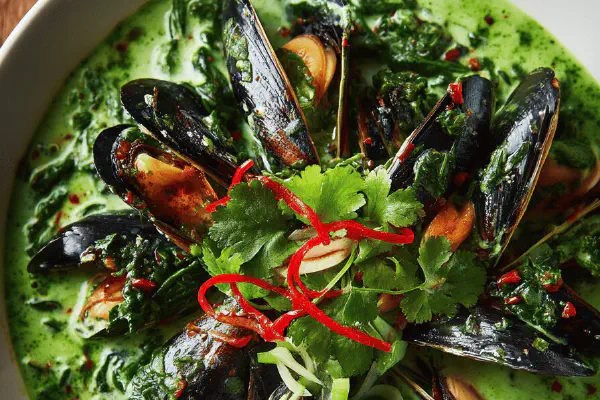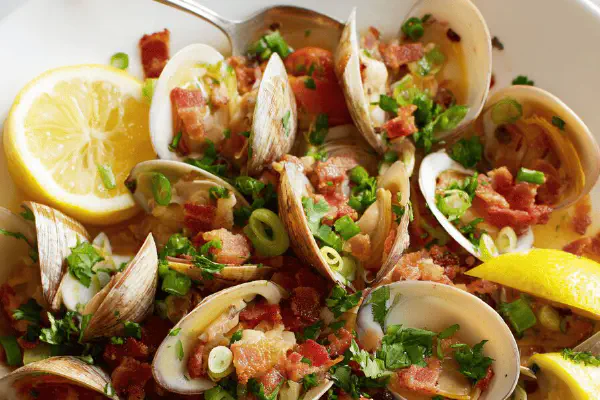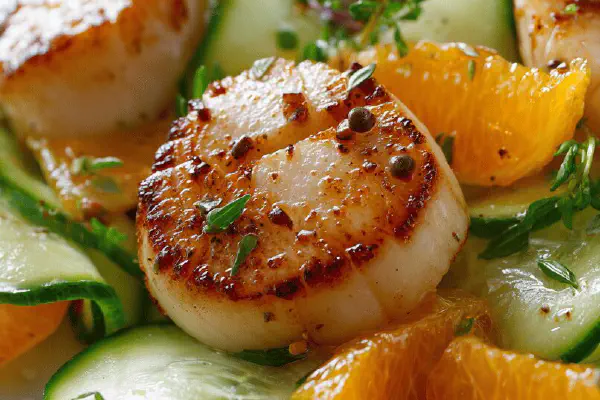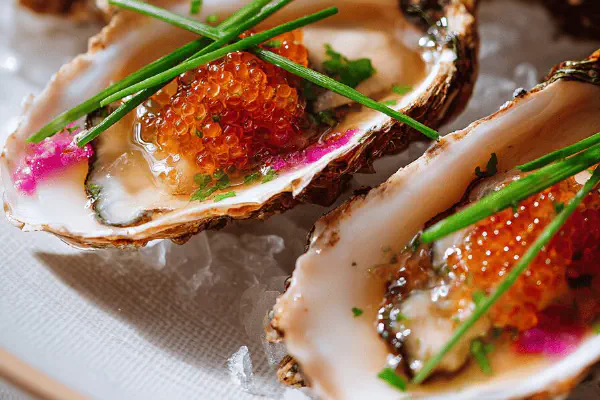Seared Cod Couscous Grapefruit
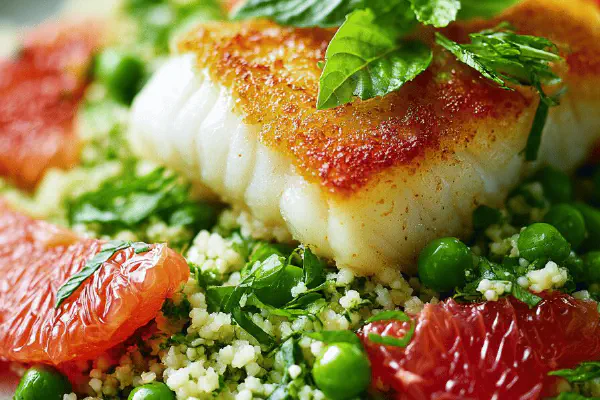
E
By Emma
Certified Culinary Professional
•
Recipe tested & approved
Seared cod fillets served with pesto-infused couscous mixed with peas and ruby grapefruit segments. Uses honey to balance citrus tang. Cooking revolves around timing to get crisp crust on fish and fluffy grains without mush. Includes tips for preserving bright colors and enhancing flavors with fresh basil. Handles common slip-ups like overcooked peas and soggy couscous. Alternative herb pesto suggested, plus twist with a zingy dressing made from grapefruit juice and honey. Practical, sensory cues prioritized over strict timings for cooks who trust their instincts.
Prep:
15 min
Cook:
12 min
Total:
27 min
Servings:
4 servings
#seafood
#quick dinner
#French-inspired
#citrus
#healthy meal
Peeling back layers on seared cod paired with couscous loaded with pesto and bright grapefruit segments. Always relying on visual and tactile clues more than exact numbers. Peas tossed right after blanching to lock in color; flaky couscous gets a lift from zesty citrus and creamy herb sauce. Getting crispy skin or crust on cod demands patience — trying to lift it prematurely leads to leaving half behind. Tried butter but swapped olive oil for a cleaner finish and better browning control at home. Ever notice how grapefruit juice salty hints bring out fish’s natural sweetness? Takes a little practice getting timing right, but that smell of caramelizing fish and sharp basil makes it worth it. Uncomplicated ingredients, but watch your water ratios on couscous or you end with gluey grains.
Ingredients
- 210 g couscous (about 1 cup)
- 140 g frozen petite peas
- 60 ml basil pesto (homemade or prepared)
- 1 pink grapefruit
- 20 ml honey (about 1 tablespoon)
- 700 g cod fillets, divided into 4 pieces
- 25 ml olive oil (to substitute butter)
- Fresh basil leaves to garnish, optional
About the ingredients
If no basil pesto, blend fresh basil, pine nuts, garlic, parmesan, olive oil as substitute. Prefer arugula pesto for peppery twist but keep quantities similar to not overpower. Frozen peas can be replaced with fresh when in season; blanch only briefly to retain snap. Grapefruit segments give natural tartness, but blood orange works as alternative for sweeter notes. Honey can be subbed with maple syrup or agave but adjust quantity as sweetness differs. Butter lends richness but olive oil resists burning better at high heat; half and half works, but avoid pure butter for searing tough fillets. Cod is forgiving, but thicker fillets benefit from resting outside the fridge for 15 minutes prior to cooking to avoid cold center that resists doneness.
Method
- Heat water to boiling, reserve 250 ml separately.
- Dump couscous in a bowl, pour 250 ml boiling water over it, cover, let sit 5 minutes.
- Deflake couscous with a fork. Meanwhile, plunge peas in salted boiling water for about 1 1/2 minutes only, scoop with slotted spoon, transfer to cold water bath to halt cooking and keep color.
- Drain peas well, fold into couscous with pesto. Season with salt and pepper. Keep warm covered.
- Peel grapefruit like an orange removing all white pith leaving just fruit. Over a bowl to catch juice, segment fruit by cutting between membranes; chop segments roughly and toss into couscous.
- Mix grapefruit juice with honey, stir until combined. Taste to adjust balance.
- Heat a skillet over medium-high heat, add olive oil. When shimmering, add cod fillets, skin side down or flat side if skinless. Let cook undisturbed until golden brown edges appear and fish releases easily from pan, about 3-4 minutes.
- Flip carefully, season with salt and pepper. Add grapefruit-honey mixture to pan, spoon over fish.
- Lower heat slightly. Cook another 3-4 minutes or until fish is opaque and flakes easily with a fork. Watch for bubbling sauce and reduce if running too thin.
- Plate couscous, mound fish on top, drizzle with pan sauce. Scatter fresh basil for herbaceous lift. Serve immediately.
Cooking tips
Boiling water poured over couscous should be nearly boiling; underheated water results in uneven grains. Fluffing couscous is key — break all clumps with a fork, not stir — avoids pasty texture. Watch peas carefully; overcooking ruins color and sweetness; shocking in ice water arrests cooking fast. Segmenting grapefruit over a bowl captures irreplaceable juice, don’t discard. Use a sharp, flexible knife to separate membranes cleanly; missed bits can add bitterness. Searing cod needs high heat and dry fillets — pat them dry thoroughly. Resist turning too soon or fish tears. When adding sauce, lower heat a bit; too high burns the honey and darkens the pan. Use sauce to baste fish, keeps moist, adds gloss. Serve straightaway; leftover pan sauce thickens on cooling so spoon liberally while hot. Fresh basil is not optional — fresh aroma cuts citrus and fish.
Chef's notes
- 💡 Pat fish skin dry before searing to avoid splatter, helps skin crisp up. Heat pan medium-high but monitor carefully. If fish sticks, likely not ready to flip. Wait for edges to turn golden then flip gently. Avoid crowding pan, do batches if needed.
- 💡 Blanch frozen peas no longer than 90 seconds or color dulls, flavor fades fast. Immediately shock in ice water bath to stop cooking, retain bright green and snap. Drain very well before folding into couscous or pesto waters it down.
- 💡 Fluff couscous with fork only, no stirring. Stirring breaks grains down, ends with gluey texture. The right water ratio matters, too little – chewy clumps. Too much – mush. Pour boiling water slowly, cover well, rest 5 minutes before fluffing.
- 💡 Segment grapefruit over bowl to catch juice, don’t lose that acid punch. Use a sharp, flexible knife to clean membranes out, pith tastes bitter and ruins balance. Rough chop segments for textural contrast, mixes into grains without mushiness.
- 💡 If pesto not on hand, blend fresh basil, pine nuts, garlic, parmesan, olive oil. Arugula sub adds peppery zip but use same quantities to not overpower. For honey swap, try maple or agave adjusting for sweetness differences.
Common questions
How to know when cod is done?
Fish flakes gently with fork near thickest part. Edges turn golden first, fish should release from pan easy before flipping. Opaque all through, no raw sheen.
Can fresh peas replace frozen?
Fresh peas better if in season but blanch just briefly to keep snap and color. Overcook and flavor dulls fast. Same ice shock step applies to lock in brightness.
What if couscous turns gluey?
Usually too much water or stirred too much. Use boiling water, cover tightly, rest without disturbance. Fluff with fork only, break clumps gently after resting.
How to store leftovers?
Couscous separate in fridge with splash water to rehydrate when reheating. Fish best fresh but if saved, reheat gently in pan or oven, avoid microwave to keep texture. Sauce thickens once cooled, stir well if needed.
